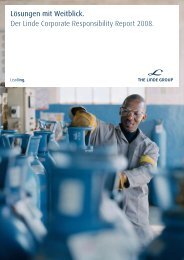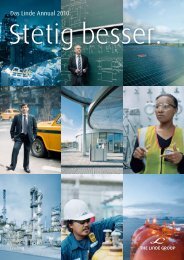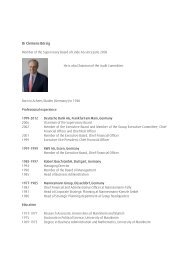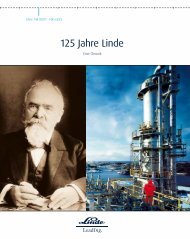The complete history of the development of The - The Linde Group
The complete history of the development of The - The Linde Group
The complete history of the development of The - The Linde Group
You also want an ePaper? Increase the reach of your titles
YUMPU automatically turns print PDFs into web optimized ePapers that Google loves.
which Güldner used as a test in 1955 in its “Hydrocar” transport<br />
vehicle (see also page 52), <strong>the</strong> group now had two new seeds<br />
for growth. It is one <strong>of</strong> Dr. Hans Meinhardt’s great entrepreneurial<br />
achievements to have recognized <strong>the</strong> significance <strong>of</strong> <strong>the</strong>se innovations<br />
and to have systematically built on <strong>the</strong>m (see also page 65).<br />
Prior to <strong>the</strong> stunning decision by <strong>the</strong> Executive Board <strong>of</strong><br />
March 21, 1969 to immediately cease tractor construction and<br />
massively expand forklift production, however, <strong>the</strong>re had been<br />
many attempts during <strong>the</strong> 1960s to streamline tractor and<br />
diesel engine manufacture and set <strong>the</strong>m on more stable footing.<br />
<strong>The</strong> Werksgruppe Güldner in 1958 had announced a close<br />
collaboration with Maschinenfabrik Fahr in Baden. Beginning in<br />
1959, both companies produced tractors in <strong>the</strong> “Europa series”<br />
that were nearly identical in construction. This collaboration<br />
broke up after Fahr was taken over in 1961 by its competitor<br />
Deutz.<br />
When a sale <strong>of</strong> <strong>the</strong> motor and tractor business fell through,<br />
<strong>the</strong> Executive Board finally put an end to tractor and diesel<br />
engine production due to dramatically increasing losses. Güldner<br />
had produced some 300,000 diesel engines and 100,000 tractors<br />
in Aschaffenburg by that point.<br />
Entry into large plant engineering<br />
Plant engineering on <strong>the</strong> o<strong>the</strong>r hand was growing by <strong>complete</strong>ly<br />
new dimensions in Höllriegelskreuth during <strong>the</strong> 1950s.<br />
While international customers were ordering primarily oxygen<br />
and nitrogen plants in <strong>the</strong> early 1950s, <strong>Linde</strong> was soon involved<br />
in new applications for gas separation in <strong>the</strong> petrochemical<br />
industry, which soon became <strong>the</strong> most important customers.<br />
For <strong>Linde</strong> <strong>the</strong>se orders meant entering <strong>the</strong> field <strong>of</strong> large<br />
plant engineering, with <strong>complete</strong>ly new technical and financial<br />
challenges: <strong>the</strong> trend towards <strong>complete</strong> “turnkey” solutions.<br />
Despite a lack <strong>of</strong> experience in this field, <strong>Linde</strong> made <strong>the</strong> daring<br />
leap, becoming a supplier <strong>of</strong> <strong>complete</strong> large plants. This was a<br />
very risky field, but one which could be just as rewarding.<br />
1966 1967<br />
Mao Tse-tung ignites <strong>the</strong> “Cultural<br />
Revolution” in China.<br />
N o 1593 Process and device for <strong>the</strong> residual purification<br />
<strong>of</strong> gas mixtures during low-temperature rectification at <strong>the</strong> temperature<br />
<strong>of</strong> liquid hydrogen (–252.8 °C) (cryotechnology).<br />
N o 1712 Plate condenser evaporator,<br />
especially for gas and air separators.<br />
Dr.-Ing. Johannes Wucherer (born in 1906)<br />
Dr.-Ing. Johannes Wucherer, chairman <strong>of</strong> <strong>the</strong><br />
Executive Board from 1961 to 1972.<br />
<strong>The</strong> son <strong>of</strong> <strong>Linde</strong> Executive Board Chairman<br />
Rudolf Wucherer and grandson <strong>of</strong><br />
Carl von <strong>Linde</strong> studied mechanical engineering<br />
at <strong>the</strong> Technical University in<br />
Munich and receiving his Doctorate in<br />
engineering (Dr.-Ing.) in 1931 from <strong>the</strong><br />
Technical University in Dresden. He<br />
remained in Dresden as assistant to <strong>the</strong><br />
famous <strong>the</strong>rmodynamics expert Pr<strong>of</strong>.<br />
Richard Mollier until 1934.<br />
That year he started his career at <strong>the</strong><br />
<strong>Linde</strong> Company in Wiesbaden in <strong>the</strong><br />
inspection <strong>of</strong>fice for refrigeration systems.<br />
In 1937 he transferred to Höllriegelskreuth<br />
and was soon <strong>the</strong> closest employee to his<br />
uncle Richard <strong>Linde</strong>, who at that time<br />
managed facilities engineering. During this<br />
period, Johannes Wucherer played a leading<br />
role in <strong>the</strong> continuing <strong>development</strong> <strong>of</strong><br />
low-temperature technology, <strong>the</strong> <strong>Linde</strong>-<br />
Fränkl process and ethylene production.<br />
“Six-Day War” between Israel and Arab<br />
neighbors Egypt, Jordan and Syria.<br />
On October 1, 1954 he became a<br />
deputy member and in 1957 a regular<br />
member <strong>of</strong> <strong>the</strong> Executive Board. While<br />
he was in <strong>of</strong>fice, <strong>the</strong> Executive Board and<br />
Supervisory Board <strong>of</strong> <strong>Linde</strong> AG restructured<br />
<strong>the</strong> responsibilities <strong>of</strong> <strong>the</strong> central<br />
administration in Wiesbaden and <strong>the</strong><br />
division <strong>of</strong> labor in <strong>the</strong> Executive Board<br />
so that <strong>the</strong> central administration in<br />
Wiesbaden played a stronger role.<br />
In 1972, Johannes Wucherer retired<br />
from his position in favor <strong>of</strong> Hermann<br />
<strong>Linde</strong> and was appointed to <strong>the</strong> Supervisory<br />
Board. Johannes Wucherer lives<br />
in Diessen am Ammersee.<br />
57



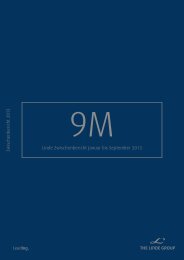
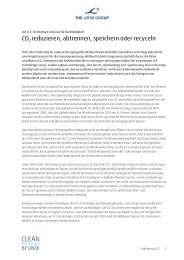

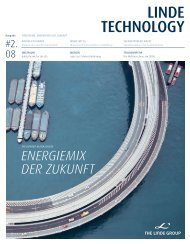
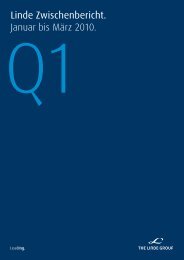
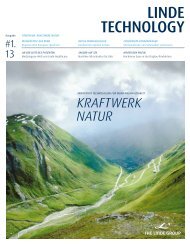
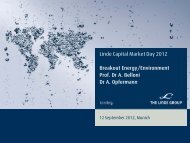
![[41] Anteilsbesitzliste des Linde Konzerns und ... - The Linde Group](https://img.yumpu.com/8356102/1/184x260/41-anteilsbesitzliste-des-linde-konzerns-und-the-linde-group.jpg?quality=85)
![[41] Anteilsbesitzliste des Linde Konzerns und ... - The Linde Group](https://img.yumpu.com/8356076/1/184x260/41-anteilsbesitzliste-des-linde-konzerns-und-the-linde-group.jpg?quality=85)
